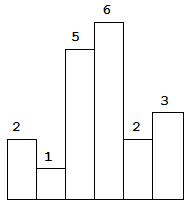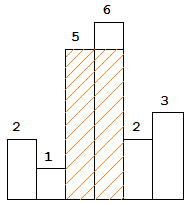题目地址: https://leetcode.com/problems/largest-rectangle-in-histogram/description/
题目描述
Given n non-negative integers representing the histogram's bar height where the width of each bar is 1, find the area of largest rectangle in the histogram.

Above is a histogram where width of each bar is 1, given height = [2,1,5,6,2,3].

Thelargest rectangle is shown in the shaded area, which has area = 10 unit.
Example:
Input: [2,1,5,6,2,3]
Output: 10
题目大意
计算一堆矩形能够成的面积最大的一块是多少。
解题方法
单调栈
这个题是单调栈的运用,使用一个单调递增栈来维护已经出现了的矩形高度。
1、 如果后面新来的元素高度比栈顶元素高,那么需要入栈,因为面积最大的元素会出现在后面;
2、 如果后面新来的元素高度比栈顶元素小,那么需要弹出栈里的元素,并且,每次弹出的时候都要对计算目前的宽度,相乘得到面积;
栈里保存索引的方式是需要掌握的,保存索引的方式在最小值栈结构中也有运用。
每次求栈内矩形的宽度的时候,其实是求其位置到最右边的距离。注意即将入栈的元素索引 i 是一直不变的,另外栈里的每个元素的索引可以认为是矩形的右边界。
Leetcode #84 Largest Rectangle in Histogramopen in new window图文并茂,讲得很清楚。
最坏时间复杂度是O(N^2),最优时间复杂度是O(N),空间复杂度是O(N)。
class Solution(object):
def largestRectangleArea(self, heights):
"""
:type heights: List[int]
:rtype: int
"""
stack = list()
res = 0
heights.append(0)
N = len(heights)
for i in range(N):
if not stack or heights[i] > heights[stack[-1]]:
stack.append(i)
else:
while stack and heights[i] <= heights[stack[-1]]:
h = heights[stack[-1]]
stack.pop()
w = i if not stack else i - stack[-1] - 1
res = max(res, h * w)
stack.append(i)
return res
1 2 3 4 5 6 7 8 9 10 11 12 13 14 15 16 17 18 19 20 21
参考资料:
https://www.cnblogs.com/boring09/p/4231906.html
DDKK.COM 弟弟快看-教程,程序员编程资料站,版权归原作者所有
本文经作者:负雪明烛 授权发布,任何组织或个人未经作者授权不得转发